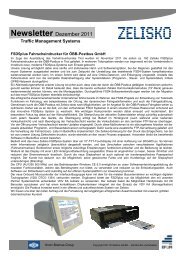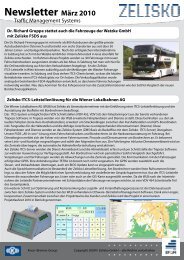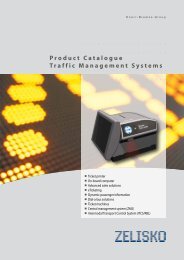Annual Report 2012 - Knorr-Bremse AG.
Annual Report 2012 - Knorr-Bremse AG.
Annual Report 2012 - Knorr-Bremse AG.
Create successful ePaper yourself
Turn your PDF publications into a flip-book with our unique Google optimized e-Paper software.
68 <strong>Report</strong> ProduCts // Commercial vehicle systems<br />
SafetyDirect monitors data coming from safety systems to display driver performance information<br />
over time. Using the AutoVue LDW system to gather data from the vehicle, the SafetyDirect web<br />
portal allows fleet owners the opportunity to analyze safety information about their vehicles that<br />
is wirelessly transmitted – in real time – via telematics systems already installed on the vehicles. SafetyDirect<br />
can provide an immediate warning through email to fleet operators if their drivers are braking<br />
too hard or traveling too fast. The wireless data is transmitted to a fleet’s back office, eliminating<br />
the need for technicians to manually extract it from the vehicles. The video and other trending data<br />
is delivered by SafetyDirect in a fraction of the time. This helps fleet managers make key decisions,<br />
such as identifying risky driver behavior and providing targeted training for drivers.<br />
New steering brake for truck applications prevents understeer<br />
Classic three-axle construction site vehicles often suffer from understeer when cornering. Particularly<br />
in the slippery conditions encountered in building excavations or quarries, even a modern vehicle<br />
can be difficult to maneuver. The new steering brake function by <strong>Knorr</strong>-<strong>Bremse</strong> is intended to help<br />
the driver in such situations. Integrated into the EBS electronic braking system, it reduces the cornering<br />
radius by applying the brake on the inside rear wheels.<br />
The system functions a bit like the split brake pedal that is often found on agricultural vehicles. In the<br />
case of the steering brake, the brake cylinder on the inside rear wheels receives a higher pressure<br />
than the outside wheels, effectively countering the characteristic understeer that can be experienced<br />
on slippery surfaces. The degree of the difference in brake pressure between the two ends of the axle<br />
depends on the steering wheel angle – the further the driver turns the wheel, the more firmly the<br />
brake is applied on the inside wheel. To prevent tire scuffing the pressure is automatically reduced<br />
when the slip limit is reached.



![1 Newsletter 2013 Version 0 92 [Kompatibilitätsmodus] - Zelisko](https://img.yumpu.com/50939577/1/184x260/1-newsletter-2013-version-0-92-kompatibilitaatsmodus-zelisko.jpg?quality=85)




![Backofficelösung ZMS [PDF, 740 kB] - Zelisko](https://img.yumpu.com/33964695/1/184x260/backofficelaasung-zms-pdf-740-kb-zelisko.jpg?quality=85)

![Geschäftsbericht 2012 [PDF, 13 MB] - Zelisko](https://img.yumpu.com/31517535/1/184x260/geschaaftsbericht-2012-pdf-13-mb-zelisko.jpg?quality=85)


![Produktkatalog Gesamtlösungen [PDF, 4 MB] - Zelisko](https://img.yumpu.com/22973479/1/182x260/produktkatalog-gesamtlaasungen-pdf-4-mb-zelisko.jpg?quality=85)
![ITCS Datenblatt [PDF, 804 kB] - Zelisko](https://img.yumpu.com/22855155/1/184x260/itcs-datenblatt-pdf-804-kb-zelisko.jpg?quality=85)
![Fahrscheindrucker FSD5plus [PDF, 934 kB] - Zelisko](https://img.yumpu.com/22822643/1/184x260/fahrscheindrucker-fsd5plus-pdf-934-kb-zelisko.jpg?quality=85)
